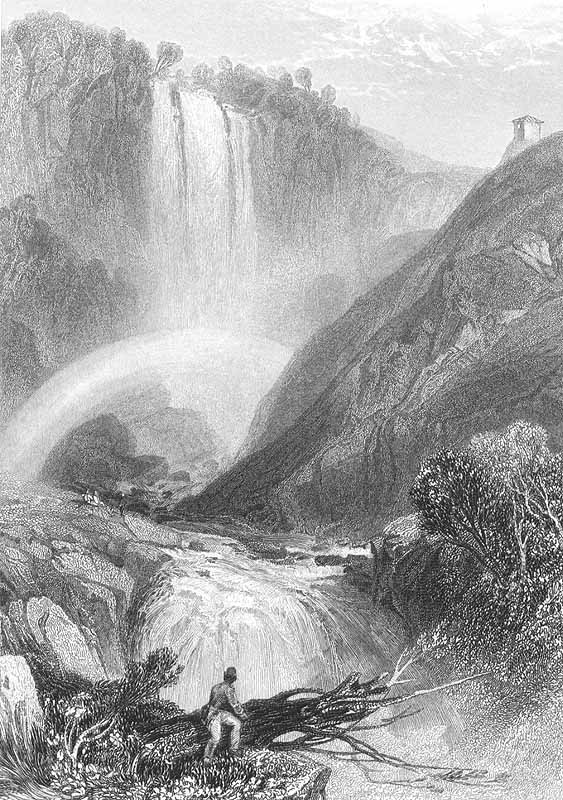|
FALLS OF TERNI
Artist: J. D. Harding ____________ Engraver: E. Finden |

Note: the title in the table above is printed below the engraving
CLICK HERE TO SEE MORE 19th CENTURY ANTIQUE PRINTS LIKE THIS ONE!!
PRINT DATE: This engraving was printed in 1833; it is not a modern reproduction in any way.
PRINT SIZE: Overall print size is 6 inches by 8 inches including white borders, actual scene is 3 1/2 inches by 4 7/8 inches.
PRINT CONDITION: Condition is excellent. Bright and clean. Blank on reverse. Paper is quality woven rag stock paper.
SHIPPING: Buyer to pay shipping, domestic orders receives priority mail, international orders receive regular air mail unless otherwise asked for. We take a variety of payment options. Full payment details will be in our email after auction close.
We pack properly to protect your item!
 DESCRIPTION OF PRINT SUBJECT: Stupendously located in a natural scenario of peerless beauty, the Marmore Waterfalls (7 km from Terni along the Valnerina state road) is an artificial work built by the Romans. In 290 BC the consul Curio Dentato ordered a canal to be dug (Cavo Curiano) in order to make the stagnant waters of the Velino river flow down into the Rieti valley conveying it to the Marmore cliff, from where it was made to fall down onto the bed of the river Nera below with a jump of 165 metres. At that time the work was heralded as a great event and certainly contributed to stengthen the prestige of Rome among the inhabitants of Umbria, recently conquered. But popular imagination prefers to give it a mythological origin: the story goes that the nymph Nera had fallen in love with a shepherd, Velino, but Juno to punish her transformed her into a river, the Nera. Velino, anguished, threw himself down from the Marmore cliff in order to be united with his beloved: that mortal jump would continue for eternity. In every era the beauty of the Waterfalls has inspired poets and artists; numerous reproductions of Italian and foreign artists exist; it seems that Virgil referred to the Marmore Waterfalls when he quotes in the Aeneid, VII book, a valley of dark woodlands and between the trees a river which thunders and falls over big stones. Also G. Byron in his Childe Harolds Pilgrimage sings the praises of the Waterfall describing it as one of the most fascinating spectacles ever seen during his numerous journeys.
DESCRIPTION OF PRINT SUBJECT: Stupendously located in a natural scenario of peerless beauty, the Marmore Waterfalls (7 km from Terni along the Valnerina state road) is an artificial work built by the Romans. In 290 BC the consul Curio Dentato ordered a canal to be dug (Cavo Curiano) in order to make the stagnant waters of the Velino river flow down into the Rieti valley conveying it to the Marmore cliff, from where it was made to fall down onto the bed of the river Nera below with a jump of 165 metres. At that time the work was heralded as a great event and certainly contributed to stengthen the prestige of Rome among the inhabitants of Umbria, recently conquered. But popular imagination prefers to give it a mythological origin: the story goes that the nymph Nera had fallen in love with a shepherd, Velino, but Juno to punish her transformed her into a river, the Nera. Velino, anguished, threw himself down from the Marmore cliff in order to be united with his beloved: that mortal jump would continue for eternity. In every era the beauty of the Waterfalls has inspired poets and artists; numerous reproductions of Italian and foreign artists exist; it seems that Virgil referred to the Marmore Waterfalls when he quotes in the Aeneid, VII book, a valley of dark woodlands and between the trees a river which thunders and falls over big stones. Also G. Byron in his Childe Harolds Pilgrimage sings the praises of the Waterfall describing it as one of the most fascinating spectacles ever seen during his numerous journeys.

Please note: the terms used in our auctions for engraving, etching, lithograph, plate, photogravure etc. are ALL prints on paper, and NOT blocks of steel or wood or any other material. “ENGRAVINGS”, the term commonly used for these paper prints, were the most common method in the 1700s and 1800s for illustrating old books, and these paper prints or “engravings” were created by the intaglio process of etching the negative of the image into a block of steel, copper, wood etc, and then when inked and pressed onto paper, a print image was created. These prints or engravings were usually inserted into books, although many were also printed and issued as loose stand alone lithographs. They often had a tissue guard or onion skin frontis to protect them from transferring their ink to the opposite page and were usually on much thicker quality woven rag stock paper than the regular prints. So this auction is for an antique paper print(s), probably from an old book, of very high quality and usually on very thick rag stock paper.
A RARE FIND! AND GREAT DECORATION FOR YOUR OFFICE OR DEN WALL.
|
